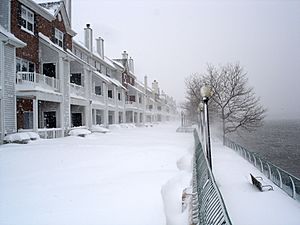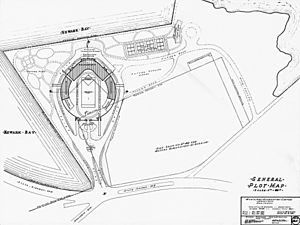Droyer's Point facts for kids
Droyer's Point is a special area in Jersey City, New Jersey. It sits right on the edge of Newark Bay. This spot used to be home to the Jersey City Airport and later a famous sports stadium called Roosevelt Stadium. Both of these are gone now. Today, Droyer's Point is a lively place with homes and businesses.
Contents
Exploring Droyer's Point: Where Is It?
Droyer's Point is in the southwest part of Jersey City. It's right on the Newark Bay. You can get there from New Jersey Route 440 at Danforth Avenue. To the north, Kellog Street marks its border. This area is across from Kearny Point. Together, they mark the entrance to the Hackensack River.
What's Droyer's Point Like Today?

Since the 1990s, Droyer's Point has become a place for homes and fun. At its southern end, you'll find the Athletic Complex of New Jersey City University. Just north of that are homes built by Hovnanian Enterprises. Before building started, the land had to be cleaned up. This was because some chemicals were found there.
Society Hill and Droyer's Point Homes
The first homes, called Society Hill, were built around 1993-1994. More homes followed in 1995-1996. The Droyer's Point townhouses were built around 2003-2004. These communities have different types of homes. They include condos and rental townhomes and apartments. Residents can enjoy pools, tennis courts, clubhouses, and a marina. A public path called the Hackensack RiverWalk runs along the shoreline. It's a great place to walk and enjoy the water views.
A Look Back: History of Droyer's Point
Ancient Times: Minkakwa and the Morris Canal
Long ago, this area was a tidal marsh. Native American tribes like the Hackensack and Raritan lived here. They called the spot Minkakwa. This name meant "a place of good crossing." It was a good place to cross between two bays.
Later, in the 1830s, the Morris Canal was built. It used the natural landscape to cut across the land. The canal ran next to the bay. You can still see parts of the old canal route today.
Flying High: Jersey City Airport
In the 1920s, the city decided to develop this land. They filled in parts of the marsh. They wanted to expand the city's port. While port plans didn't fully happen, the area became home to the Jersey City Airport. It opened in 1927.
A young pilot named Eddie August Schneider operated the airport for a short time. After World War Two, three former Navy pilots started Jersey Skyports. It ran for five years. There was also a nearby seaplane base.
Sports and Shows: Roosevelt Stadium
The famous Art Deco style Roosevelt Stadium was a big project. It was built during the Great Depression. The stadium was named after President Franklin D. Roosevelt. It opened on April 23, 1937. The mayor of Jersey City even declared a half-holiday for the opening!
Roosevelt Stadium was home to the Jersey City Giants baseball team. The Brooklyn Dodgers also played some games there. A very important event happened on April 18, 1946. Jackie Robinson made his professional baseball debut there. He played for the Montreal Royals against the Jersey City Giants.
The stadium also hosted many exciting boxing matches. Famous boxers like Max Baer and Sugar Ray Robinson fought there. In the 1970s, it became a popular concert venue. Bands like the Grateful Dead, Allman Brothers Band, and Beach Boys performed there. The stadium was torn down in 1985.
Getting Around Droyer's Point
You can get to Droyer's Point using New Jersey Transit buses. These buses go to Journal Square. There's also talk about extending the Hudson Bergen Light Rail to the waterfront. But there's no set date for this project yet. The Danforth Avenue Station is about a mile away. Private buses also offer direct service to Manhattan.



